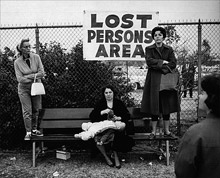 It is an injustice of history that René Burri’s 1963 photograph of a dashing young Che Guevara, meaty Cuban cigar in his lips, and head tilted to one side as he contemplates a matter of lost consequence, has taken a backseat in popularity to Guevara’s more confrontational likenesses. Burri’s image, which captures a mix of casualness and intensity, private indulgence and political judgment, is so much more interestingly ambivalent, and would for that matter be a much better choice for decorating a college dorm room than the ubiquitous photo of Che with his starred beret staring angrily into the future.
It is an injustice of history that René Burri’s 1963 photograph of a dashing young Che Guevara, meaty Cuban cigar in his lips, and head tilted to one side as he contemplates a matter of lost consequence, has taken a backseat in popularity to Guevara’s more confrontational likenesses. Burri’s image, which captures a mix of casualness and intensity, private indulgence and political judgment, is so much more interestingly ambivalent, and would for that matter be a much better choice for decorating a college dorm room than the ubiquitous photo of Che with his starred beret staring angrily into the future.
Burri’s “Che Guevara, Havana, Cuba, 1963” is one of a hundred photographs in the Portland Museum of Art’s “In Our Time: The World as Seen By Magnum Photographers,” on view through June 4. It’s quite literally a catalogue of the most virtuosic photojournalistic photographs in the last half-century.
“Don’t you think George Clooney could play Che in a movie?” a guard asked me as we found ourselves standing next to Burri’s work. “Look at him here,” he said, gesturing at Che’s T-zone — the invisible cross formed across the face by the intersecting line of the brow and the vertical axis of the body. You aim for it if you want your shot to be lethal. “Here, through the eyes. He’d be a dead ringer.”
Versions of Clooney’s various roles popped up in my memory: the ER doctor, the handyman on The Facts of Life. I agreed, the resemblance was powerful. And it’s more than just a likeness in physical appearance, as Clooney’s battles with Bill O’Reilly attest.
In a recent interview with performance theorist Peggy Phelan, critic Irit Rogoff wrote about visiting a Jackson Pollock retrospective at the Tate Modern in London; as she and a friend were poised to take the typical route through the museum, they caught a glimpse of another ER actor, Julianna Margulies. Intrigued fans, they followed her around the museum instead of the threads of curatorial logic.
Rogoff and her fellow visitor “discussed everything about [Margulies]; the guy she was with, the color of her hair, linking that with episodes of ER. And after a while, I thought with relief that all we’d done was switch structures — from being in a fan structure of Abstract Expressionism and its heroics and its masculinity to being [in another] fan structure, of celebrity and glamor and television... It’s that kind of admiration, and the illusion of proximity, and the investigative urge that’s really important.”
So rather than play the role of good visitor to the museum, the two of them cruised along as amateur ethnographers. “Part of what was interesting about seeing [Margulies] at the Tate was that collapse of one mode of American innovation and freshness and energy” — as in Pollock’s painting — “into another mode of American innovation and freshness and energy” — which we see in ER’s fast cuts and hyper-speed storyline. Rogoff notes that on a certain professional level, “You can’t respectably say that Jackson Pollock and ER are connected, but through this participatory ethnographic notion, you can begin to make connections.”